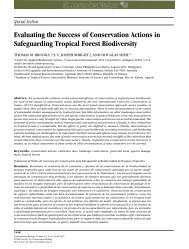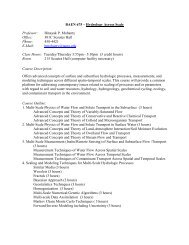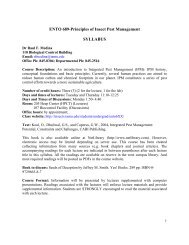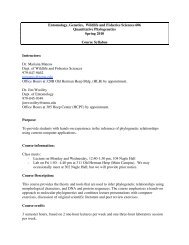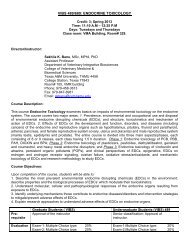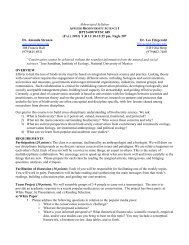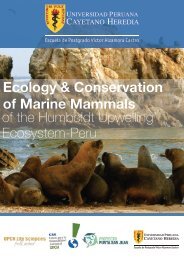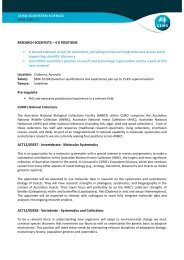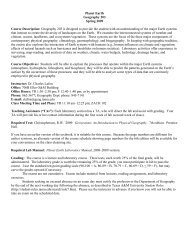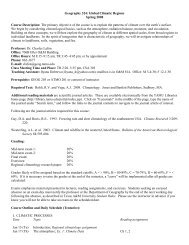SYLLABUS - Ecology and Evolutionary Biology
SYLLABUS - Ecology and Evolutionary Biology
SYLLABUS - Ecology and Evolutionary Biology
Create successful ePaper yourself
Turn your PDF publications into a flip-book with our unique Google optimized e-Paper software.
expressions describing processes <strong>and</strong> interactions in conceptual models. (Case study reflections<br />
<strong>and</strong> discussions; oral midterm <strong>and</strong> final)<br />
b. Students will be able to simplify models by identifying circumstances under which spatial or<br />
temporal scales separate. (Case study reflections <strong>and</strong> discussions; oral midterm <strong>and</strong> final)<br />
c. Students will be able to use dynamical systems theory to make qualitative predictions about the<br />
behavior of their models. They will be able to predict the existence of fixed points <strong>and</strong> evaluate<br />
their stabilities, predict the existence of limit cycles, identify critical parameters <strong>and</strong> predict<br />
bifurcations <strong>and</strong> catastrophes, <strong>and</strong> underst<strong>and</strong> the circumstances under which chaotic behavior<br />
is possible. (Case study reflections <strong>and</strong> discussions; oral midterm <strong>and</strong> final)<br />
5) discuss <strong>and</strong> critique geobiological models.<br />
a. Students will use the reasoning outlined in goals 1–4 to evaluate the reasoning <strong>and</strong> assumptions<br />
in modern integrative geobiological models. (Case study reflections <strong>and</strong> discussions; term<br />
project <strong>and</strong> presentation)<br />
Names<br />
Telephone number<br />
Email addresses<br />
Office hours<br />
Office locations<br />
Mike Tice<br />
845-3138<br />
tice@geo.tamu.edu<br />
TBA<br />
Halbouty 314<br />
Instructor Information<br />
Textbook <strong>and</strong>/or Resource Material<br />
There will be one reading from the primary literature each week which will be required for participation<br />
in Friday case study discussions. In addition, there will be up to two short optional readings (tutorials) provided<br />
each week that may be helpful background reading for the case studies. These tutorials will not be discussed in<br />
class. There is no required textbook.<br />
Grading Policies<br />
Activities forming the basis for learning evaluations will be 1) participation in classroom discussions<br />
(20%); 2) written summaries <strong>and</strong> reflections of weekly readings from the primary literature (20%); 3) a term<br />
project analyzing a specific geobiological system (20%); <strong>and</strong> 4) a midterm (20%) <strong>and</strong> final exam (20%). Final<br />
grades will be assigned based on weighted averages of graded activities rounded to the first decimal place (e.g.<br />
89.84% → 89.8%) <strong>and</strong> the following distribution: A = 90-100%, B = 80-89.9%, C = 70-79.9%, D = 60-69.9%, F ≤<br />
59.9%.<br />
Case Studies. Each of the first 12 weeks will include analysis of one case study from the primary<br />
literature. Students will work in groups to read one paper <strong>and</strong> analyze it using models <strong>and</strong> theories discussed in<br />
class. Each student will individually write a short (1–3 page) first-person reflection on that paper explaining their<br />
analyses in logical steps (e.g. “I didn’t find the authors’ approach obvious, so I reasoned in the following way in<br />
order to identify it.”). These reflections should be type-written <strong>and</strong> will prepare students for case study discussions<br />
each Friday. Discussions will be student-led, but discussion leaders will be selected by the instructors r<strong>and</strong>omly<br />
throughout the Friday session. Students are encouraged to add additional notes to their reflections in blue ink prior<br />
to h<strong>and</strong>ing them in at the end of discussion.<br />
Term Project. Each student will select a geobiological system to analyze <strong>and</strong> present to the class in a slide<br />
presentation. The instructors will guide students in selecting topics appropriate for modeling using techniques<br />
described in this class. Topics presented in term projects will form part of the material tested in the final.<br />
Midterm <strong>and</strong> Final. Students will be given small geobiological models to analyze over the course of one<br />
hour. They will then present their analyses orally to the instructors. The oral presentation <strong>and</strong> discussion will form<br />
the basis for the test grades.<br />
Course Topics, Calendar of Activities, Major Assignment Dates<br />
Week Topic Required Reading<br />
1 One-Dimensional Models in Geobiology: Population<br />
growth; one-component reaction kinetics<br />
Case Study: As(III)-oxidizing phototrophs<br />
Tutorials: Oxidation/reduction reactions <strong>and</strong><br />
metabolism; measuring bacterial growth<br />
- 2 -<br />
Kulp et al., 2008, Arsenic(III) fuels<br />
anoxygenic photosynthesis in hot<br />
spring biofilms from Mono Lake,<br />
California, Science 321:967–970.



